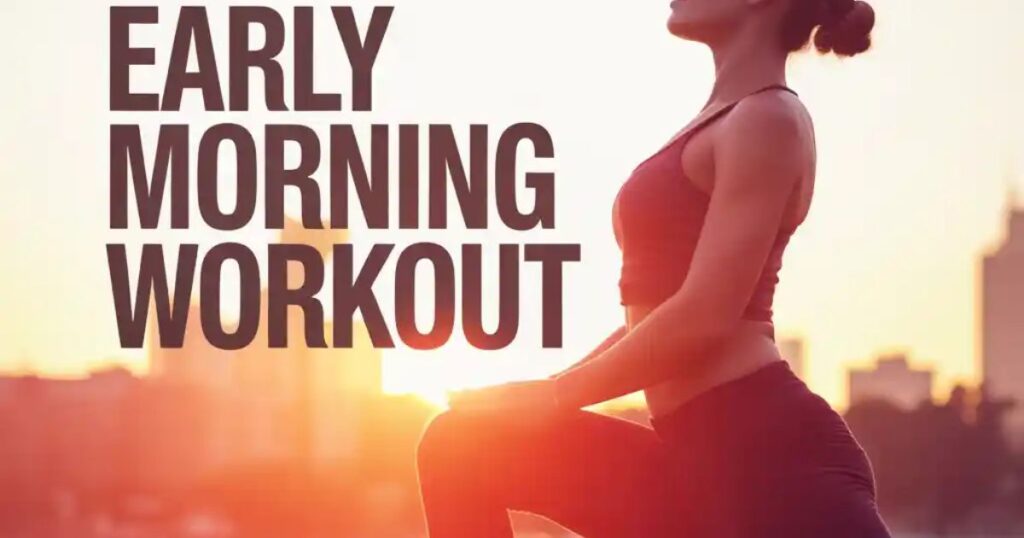Introduction: 9 Game-Changing Early Morning Workout
Starting your day with an early morning workout might feel tough at first, but it can truly change your mindset and energy levels. Morning movement helps wake up your body, lifts your mood, and boosts calorie burn for the rest of the day. Even simple body weight exercises done before breakfast can make you feel more alive and focused.
Whether you follow a fast-morning routine or take time for full at-home workouts, this habit builds consistency and motivation. It supports daily movement for longevity and helps you stay on track with your fitness goals. If you’re ready to take control of your health, mornings are the perfect place to begin.
Why Morning Workouts Give You the Best Results
There’s strong science behind benefits of short early morning workouts. When you exercise in the morning, your body burns more fat because your insulin levels are lower after sleep. It also boosts your metabolism, which keeps you burning calories all day. That’s why early workouts are perfect for fat-burning moves and daily movement for longevity.
Morning exercise also improves mental clarity and lowers stress. You’ll feel more awake and ready for the day. This is part of the reason why many experts say is it good to exercise after waking up? Absolutely yes. A good morning session acts as an energy-boosting exercise, giving you better focus and less anxiety.
Best Body weight Exercises to Kickstart Your Day
Starting your day with simple exercises like push-ups and squats can activate every major muscle. These muscle activation movements don’t need any equipment and are used in elite functional fitness programs. Exercises like jumping jacks, burpees, and bicycle crunches are also great to get the blood flowing. Many ask, are jumping jacks good cardio? Yes, they are excellent for increasing heart rate and warming up.
Push-ups are ideal for upper-body strength-building, while squats work your lower body and core. If you’re unsure where to begin, just start with one round of each. It’s a great way to explore how to start exercising at home and try beginner-friendly fitness without pressure.
9-Step Morning Workout Routine That Actually Works
Creating a daily workout plan helps you stay consistent and avoid overthinking. Here is a 9-step structure to build a routine you can actually stick to:
| Step | Action | Description |
| 1 | Wake Up | Open windows and hydrate |
| 2 | Light Stretch | Focus on flexibility training |
| 3 | Jumping Jacks | 1-minute full body warm-up |
| 4 | Push-ups | Focus on push-up form for beginners |
| 5 | Squats | 15 reps to start lower-body strength |
| 6 | Plank | Hold for 20–30 seconds |
| 7 | Jog in Place | 2 minutes for heart-pumping cardio |
| 8 | Cool Down Stretch | End with stretching and mobility |
| 9 | Shower + Light Meal | Refuel and refresh |
This structure supports how to build a habit of exercise because it’s easy to remember and only takes about 15 to 20 minutes.
Cardio vs Strength: What Should You Do in the Morning?
Both cardio and strength training have morning benefits. If you’re looking for quick fat loss and mental clarity, cardio gives faster results. That’s why many people use morning time for jogging benefits in the morning or light HIIT workouts. Cardio is perfect for improving endurance, burning calories, and increasing oxygen flow.
Strength training, on the other hand, helps with muscle building and long-term weight control. Exercises like squats and push-ups are great options. Mixing both types gives you the best of both worlds. So when asking, walking vs running for fat loss or strength, choose based on your goals. Just move!
What to Eat Before a Morning Workout (Without Feeling Heavy)
Eating something small before a workout is smart. It fuels your muscles and improves your performance. Good options include a banana, a piece of toast with peanut butter, or a smoothie. These give you fast energy without making you feel heavy. This is especially helpful when doing a full-body routine that demands stamina.
Avoid eating large or greasy meals before you move. Doing so can cause discomfort or fatigue. You don’t need a big breakfast; you just need something light. This method fits perfectly with a morning routine for energy and focus, and helps prevent crashes during your workout.
The Right Way to Warm-Up and Cool Down
One mistake beginners make is skipping warm-ups and cooldowns. A proper full body warm-up routine helps prepare your joints and muscles. This improves blood flow and reduces injury. It’s essential for home training where guidance is minimal. Start with light movements like arm circles, high knees, or slow jogging.
Cooling down is just as important. Simple stretching helps with flexibility training and muscle recovery. Without it, you’re more likely to feel sore or tight the next day. Cooling down also signals your body that it’s time to relax and begin healing.
Quick 20-Minute Early Morning Workout Plan (No Equipment Needed)
You don’t need a gym or fancy tools to get fit. This is no equipment needed plan can be done anywhere, even your bedroom. It includes fast morning routine steps that fit into a tight schedule.
| Exercise | Duration |
| Jumping Jacks | 2 minutes |
| Push-ups | 1 minute |
| Squats | 2 minutes |
| Plank | 30 seconds |
| Bicycle Crunches | 1 minute |
| Jog in Place | 3 minutes |
| Cool Down Stretch | 3 minutes |
This mix covers core strengthening, functional fitness, and fat-burning moves. Use a timer to keep it simple and effective.
Common Early Morning Workout Mistakes to Avoid
There are common traps that can ruin your progress. One is skipping water. Dehydration leads to tiredness and low focus. Another is training too hard without rest, which can cause burnout. Always listen to your body. These are key tips in how to stay consistent with workouts and avoid setbacks.
Form matters more than speed or reps. Many new learners ask how many squats daily for results. The truth is, form and quality matter more than numbers. Rushing through exercises causes injury and stops progress. Focus on control and steady improvement.
Staying Motivated: How to Build a Habit That Lasts
To stay motivated, make your workouts enjoyable. Music, fitness challenges, or setting small goals helps. Consistency builds results. If you keep showing up, it gets easier. Even 5 minutes of movement is better than nothing.
This approach supports exercises to boost mental health and makes your workouts part of your life. Want to know how to build a habit of exercise? Tie your workouts to daily actions like brushing teeth or making coffee. It’s that simple.
When You Should Skip Your Early Morning Workout (Yes, Really)
Yes, sometimes it’s best to rest. If you had a poor night of sleep, feel sick, or your muscles are very sore, give your body time to recover. This helps with daily movement for longevity and avoids injury.
Taking a rest day doesn’t mean you’re failing. You’re respecting your limits. You can stretch, take a walk, or meditate instead. This still supports your fitness motivation and ensures long-term progress.
FAQs About Morning Workout Routines
Is working out in the morning better for fat loss?
Yes. Morning exercise uses fat as fuel, since glycogen is lower after sleep. It’s perfect for fat-burning moves.
Can I work out on an empty stomach?
Yes, but eat something small if you’re doing intense workouts. It helps with energy-boosting exercise and better focus.
What is the best way to start exercising at home?
Use body weight exercises like push-ups, squats, and planks. These are the best early morning workout for beginners.
How do I improve my crunches?
Control your motion, don’t yank your neck. Learn how to improve crunch technique for best results.
Should I jog or walk in the morning?
Both help. For intense results, jog. For calm energy, walk. That covers jogging benefits in the morning and more.


